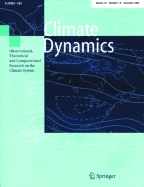Abstract.
A general circulation model is used to examine the effects of reduced atmospheric CO2, insolation changes and an updated reconstruction of the continental ice sheets at the Last Glacial Maximum (LGM). A set of experiments is performed to estimate the radiative forcing from each of the boundary conditions. These calculations are used to estimate a total radiative forcing for the climate of the LGM. The response of the general circulation model to the forcing from each of the changed boundary conditions is then investigated. About two-thirds of the simulated glacial cooling is due to the presence of the continental ice sheets. The effect of the cloud feedback is substantially modified where there are large changes to surface albedo. Finally, the climate sensitivity is estimated based on the global mean LGM radiative forcing and temperature response, and is compared to the climate sensitivity calculated from equilibrium experiments with atmospheric CO2 doubled from present day concentration. The calculations here using the model and palaeodata support a climate sensitivity of about 1 Wm-2 K-1 which is within the conventional range.
Similar content being viewed by others
Author information
Authors and Affiliations
Additional information
Received: 8 February 1997 / Accepted: 4 June 1997
Rights and permissions
About this article
Cite this article
Hewitt, C., Mitchell, J. Radiative forcing and response of a GCM to ice age boundary conditions: cloud feedback and climate sensitivity. Climate Dynamics 13, 821–834 (1997). https://doi.org/10.1007/s003820050199
Issue Date:
DOI: https://doi.org/10.1007/s003820050199
